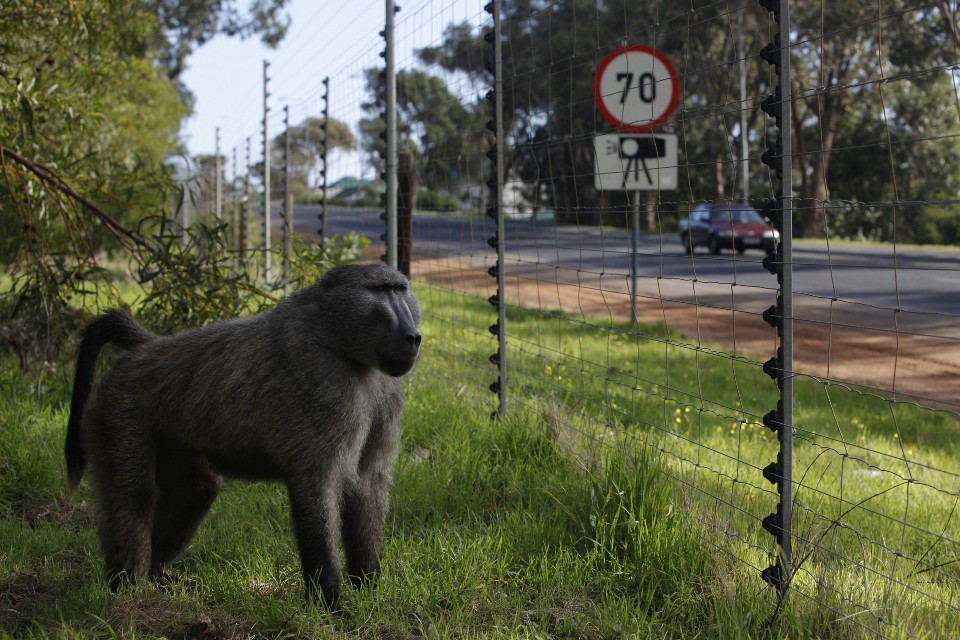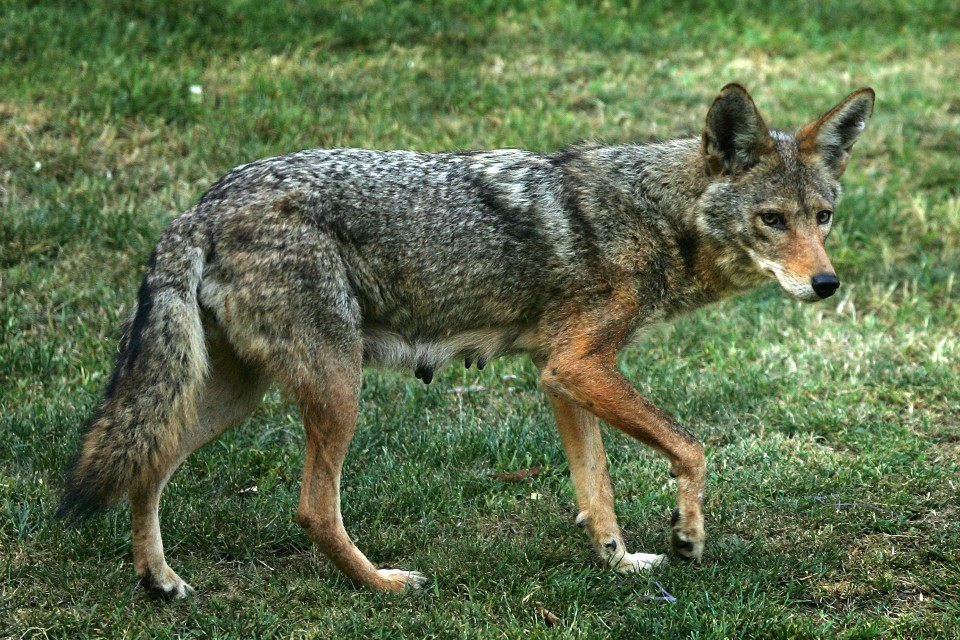Leading conservation scientists are calling for bold political action to combat the loss of our planet’s largest animals. Can they inspire us to take action?
By Jimmy Tobias
Members of the Kruger National Park keep the head of a rhinoceros up during a white rhino re-location capture on October 17, 2014. (Photo: Stefan Heunis/AFP/Getty Images)
Extinction is like gathering all the copies of a great book, burning them in some huge bonfire, and then shooting the author to boot. It’s the irretrievable loss of information — genetic information — that the forces of wild nature wrote in flesh. Africa’s western black rhinoceros is gone forever. The kouprey, a wild cow-like creature found in Asia and not seen since 1988, is likely extinct too. There are three northern white rhinos left on Earth. The last survivors of the Javan variety, about 58 individuals, are clinging to existence. The Bactrian camel and the African wild ass are both critically endangered. Lions, tigers, cheetahs, elephants, gorillas — they are all either endangered or vulnerable to extinction.
With the preceding list as preamble, 43 scientists — mostly ecologists and biologists — took to the pages of the journal BioScience in late July with an audacious appeal: “We must not go quietly into this impoverished future.”
The group, led by Oregon State University professor William Ripple, penned a manifesto of sorts to protest the imminent extinction of large carnivores and herbivores the world over. Venturing beyond the staid terms of scientific discourse, they are calling for persistent political action to combat the extinction crisis. “Under a business-as-usual scenario,” the authors write, “conservation scientists will soon be busy writing obituaries for species and subspecies … as they vanish from the planet.”
“Our hope is that this declaration, with the proposed actions and list of signatories, will attract the public and media attention that this issue requires to galvanize opinion, catalyze action, and establish new funding mechanisms.”
What we need, instead, is a popular movement that will push back against the human institutions and activities that threaten to snuff out so many of our most magnificent species.
“If [people] want to save the animals, it will have to come from the grassroots,” Ripple says. “Our political leaders probably won’t do very much unless there is pressure from the bottom up.”
Extinction’s opponents need to hit the streets. They need to march and mobilize. They need to write letters to editors and lobby their elected officials and promote an ambitious vision of wildlife protection. First, though, they need to understand the stakes. And that’s what Ripple and his colleagues set out to do: to teach.
Their article is concerned most of all with megafauna, the scientific name for the largest animals among us: the bison and bears, the big cats and behemoth herbivores. These charismatic creatures often play a “keystone” role in the ecosystems they inhabit, the scientists tell us. They exert an outsize impact on the complicated relationships that constitute the web of life. Their important ecological roles, however, can be difficult to evaluate — until they are gone.

A baboon stands behind an electric fence as he watches for a chance to break into a bakery across the street in Capetown, South Africa. (Photo: Paula Bronstein/Getty Images)
Consider the baboon raids of Africa, for instance. Researchers report baboon populations can skyrocket when an ecosystem loses top predators like lions or leopards. In search of limited food supplies, the overpopulated baboons sometimes raid local farmers’ crops, and a family can thereby lose crucial calories. As a result, people keep their children home from school to guard the food plot. The baboons also bring parasites and other disease into the human communities they frequent. The absence of top predators on the landscape leads to a cascade of unforeseen and unfortunate consequences: The lions are gone so the kids get gut parasites and lose out on education.
Elephants, rhinos, and primates, on the other hand, are known to eat tree seeds, transport the seeds in their stomachs, and then drop a pile of dung on the edge of a forest or in some grassland opening. With a little luck, the seeds germinate and forests spread, providing food and shade, wood and wildlife habitat. Without the seed dispersal role of large herbivores, some tree species across the world would struggle to re-produce and expand their range.
Keeping prey populations in check, helping spread and fertilize seeds, limiting infectious disease and invasive species, boosting wildlife tourism, providing food, offering majesty and mystery in an increasingly mechanistic world — these are just a few examples of the countless“ecosystem services” that large mammals contribute to human civilization.
It’s true. The climate movement has done an excellent job of taking what was once, for many, an abstract threat, and linking it in the public mind to wildfires, storms, sea level rise, heat waves, and the like.
But this is the anthropocentric argument against extinction. Ethics and ecology demand something more. Ripple and his colleagues write of an “abiding moral obligation to protect the Earth’s megafauna.” To say that we have a moral obligation to prevent mass extinction is to recognize that every species on Earth was created by the same ineffable forces and has an equal claim to life. To erase that creation, to discard the unprecedented genetic information that each species contains, is to foreclose future possibilities. We are burning books that don’t belong to us. We are annihilating blueprints that haven’t been built.
The traits that make megafauna such a powerful influence on landscapes and livelihoods — their large territorial needs, their predatory behavior, their beauty — also make them vulnerable to the thousand cuts of human harm.
The illegal trade in wildlife products, overhunting, persecution at the hands of ranchers, and the feverish scramble for commodities and arable land are all key factors in megafauna extinction. “Various anthropogenic forces such as deforestation, agricultural expansion, increasing livestock numbers, and other forms of human encroachment,” the authors write, “have severely degraded critical habitat for megafauna by increased fragmentation or reduced resource availability.” The Earth’s 3.9 billion ruminant livestock, like cows and sheep, are of particular concern to the scientists — these domestic species far outnumber the large wild herbivores left on the planet and compete for many of the same resources. Conspicuous consumption and immoderate meat eating are both a big part of the story here.
Mass extinction is as complex and consequential as climate change. And the dual problems are, of course, intertwined: in fossil fuel and industrial meat production, for instance, they share a common source. But only one has inspired a mass global movement that is in the streets on an almost daily basis. Extinction seems, somehow, to be a second-class crisis.
“The topic of climate change has been in the forefront longer than the animal extinction crisis,” Ripple says. “For many people, it is more obvious that they are helping save themselves when they fight against climate change or demonstrate for mitigating climate change.”
It’s true. The climate movement has done an excellent job of taking what was once, for many, an abstract threat, and linking it in the public mind to wildfires, storms, sea level rise, heat waves, and the like. Take a look at Bill McKibben’s Twitter feed, and you can see that he relentlessly ties climate change to more tangible perils.

(Photo: David McNew/Getty Images)
Extinction must be linked in a similar manner to declining human prospects. When a new infectious disease breaks out in the tropics, or spreads into our own country, we must look to see if it is somehow connected to extinction and biodiversity disruption. When wildfires rage or exotic species invade or pests devour agricultural products, is there a link to predator or herbivore extirpation? Making such connections comes first, and many scientists are doing excellent work in this arena.
In a 2014 paper in PNAS, for example, scientists theorized a clear link between the disappearance of megafauna and the rise of Lyme disease, a debilitating and occasionally deadly affliction that has spread throughout the United States. The suggested ecological cause is fascinating: Rodents are responsible for infecting most ticks with Lyme. When wolves are removed from the landscape — as they have been in much of North America — coyotes take their place as a top predator. Coyotes prey aggressively on red foxes. Foxes, for their part, are a key predator of small rodents. The cascading effects of wolf extirpation looks like this: more coyotes means fewer foxes, which means more rodents. More rodents means more Lyme-infected ticks, which means more human disease.
These are the realities of interconnectedness. They are stories too, and they can be used to make people care about species facing erasure. They can inspire outrage. We need story-based organizing that gets people out the door and in the face of decision-makers. The climate movement’s impressive use of such tactics, its mass mobilizations and social media savvy, its storytelling and debate framing, is something to aspire to.
“Our hope is that this declaration, with the proposed actions and list of signatories, will attract the public and media attention that this issue requires to galvanize opinion, catalyze action, and establish new funding mechanisms,” the scientists write. “Comprehensive actions to save these iconic wildlife species will help to curb an extinction process that appears to have begun with our ancestors in the late Pleistocene.”
It started with our ancestors, but it can stop with us. To that end, a symbol has recently emerged, one that aims to wordlessly communicate the urgency of extinction. Much like the peace sign, which originated as a protest against the equally existential threat of nuclear weapons, it is an austere figure of thick black lines on a white backdrop. It evokes an hourglass contained inside a globe. Its message is simple and severe: For so many of our fellow animals, our fellow Earth dwellers, time is running out.

||





